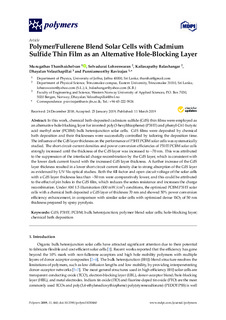| dc.contributor.author | Thanihaichelvan, Murugathas | |
| dc.contributor.author | loheeswaran, Selvadurai | |
| dc.contributor.author | Balashankar, Kailasabathy | |
| dc.contributor.author | Velauthapillai, Dhayalan | |
| dc.contributor.author | Ravirajan, Punniyamoorthy | |
| dc.date.accessioned | 2019-06-04T08:36:47Z | |
| dc.date.available | 2019-06-04T08:36:47Z | |
| dc.date.created | 2019-04-06T22:34:29Z | |
| dc.date.issued | 2019 | |
| dc.identifier.citation | Thanihaichelvan, M., Loheeswaran, S., Balashangar, K., Velauthapillai, D., & Ravirajan, P. (2019). Polymer/Fullerene Blend Solar Cells with Cadmium Sulfide Thin Film as an Alternative Hole-Blocking Layer. Polymers, 11(3). | nb_NO |
| dc.identifier.issn | 2073-4360 | |
| dc.identifier.uri | http://hdl.handle.net/11250/2599842 | |
| dc.description.abstract | In this work, chemical bath-deposited cadmium sulfide (CdS) thin films were employed as an alternative hole-blocking layer for inverted poly(3-hexylthiophene) (P3HT) and phenyl-C61-butyric acid methyl ester (PCBM) bulk heterojunction solar cells. CdS films were deposited by chemical bath deposition and their thicknesses were successfully controlled by tailoring the deposition time. The influence of the CdS layer thickness on the performance of P3HT:PCBM solar cells was systematically studied. The short circuit current densities and power conversion efficiencies of P3HT:PCBM solar cells strongly increased until the thickness of the CdS layer was increased to ~70 nm. This was attributed to the suppression of the interfacial charge recombination by the CdS layer, which is consistent with the lower dark current found with the increased CdS layer thickness. A further increase of the CdS layer thickness resulted in a lower short circuit current density due to strong absorption of the CdS layer as evidenced by UV-Vis optical studies. Both the fill factor and open circuit voltage of the solar cells with a CdS layer thickness less than ~50 nm were comparatively lower, and this could be attributed to the effect of pin holes in the CdS film, which reduces the series resistance and increases the charge recombination. Under AM 1.5 illumination (100 mW/cm2) conditions, the optimized PCBM:P3HT solar cells with a chemical bath deposited a CdS layer of thickness 70 nm and showed 50% power conversion efficiency enhancement, in comparison with similar solar cells with optimized dense TiO2 of 50 nm thickness prepared by spray pyrolysis. | nb_NO |
| dc.language.iso | eng | nb_NO |
| dc.publisher | MDPI | nb_NO |
| dc.rights | Navngivelse 4.0 Internasjonal | * |
| dc.rights.uri | http://creativecommons.org/licenses/by/4.0/deed.no | * |
| dc.subject | CdS | nb_NO |
| dc.subject | P3HT | nb_NO |
| dc.subject | PCBM | nb_NO |
| dc.subject | bulk heterojunction | nb_NO |
| dc.subject | polymer blend solar cells | nb_NO |
| dc.subject | hole-blocking layer | nb_NO |
| dc.subject | chemical bath deposition | nb_NO |
| dc.title | Polymer/Fullerene Blend Solar Cells with Cadmium Sulfide Thin Film as an Alternative Hole-Blocking Layer | nb_NO |
| dc.type | Journal article | nb_NO |
| dc.type | Peer reviewed | nb_NO |
| dc.description.version | publishedVersion | nb_NO |
| dc.rights.holder | © 2019 by the authors. | nb_NO |
| dc.subject.nsi | VDP::Teknologi: 500::Materialteknologi: 520 | nb_NO |
| dc.source.volume | 11 | nb_NO |
| dc.source.journal | Polymers | nb_NO |
| dc.source.issue | 3 | nb_NO |
| dc.identifier.doi | 10.3390/polym11030460 | |
| dc.identifier.cristin | 1690619 | |
| cristin.unitcode | 203,12,4,0 | |
| cristin.unitname | Institutt for data- og realfag | |
| cristin.ispublished | true | |
| cristin.fulltext | original | |
| cristin.qualitycode | 1 | |

